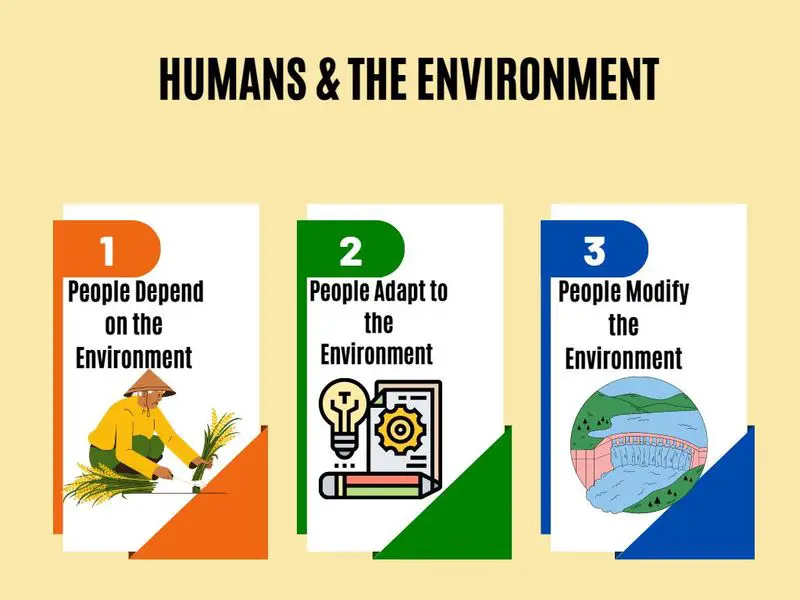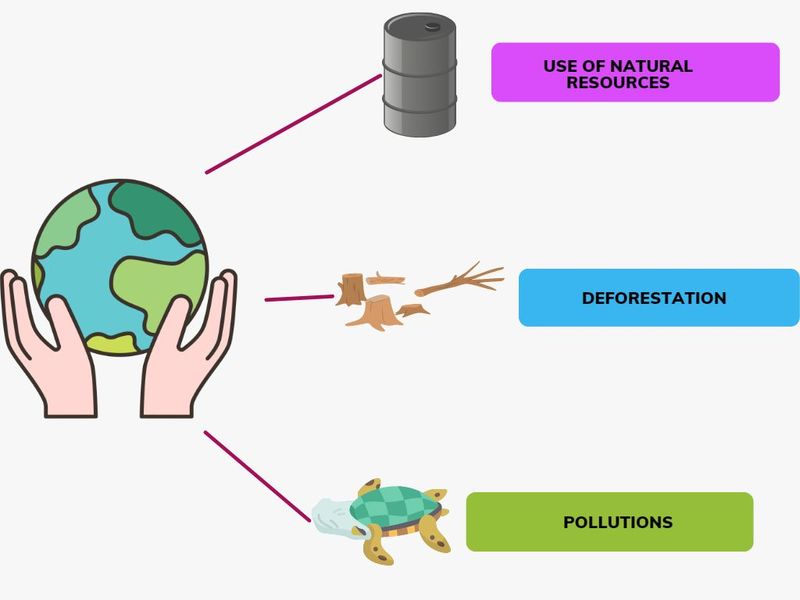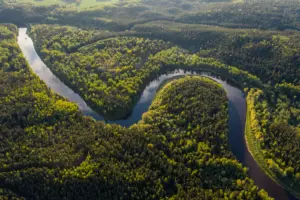
One of the most critical aspects of environmental science is understanding how to define human-environment interaction. This interaction can be defined in various ways but is most understood as how people use and modify their environment to meet their needs.
It can also be described as the interactions between social and ecological systems.
- Ecological systems provide the resources necessary for human societies to function.
- Social systems affect how these resources are used and managed.
The two systems constantly interact, and the effects of these interactions can be either positive or detrimental.
Human needs have always impacted the local ecosystems in which they live. Early human populations hunted and gathered food from their surroundings, altering the distribution and populations of animal species. With the advent of agriculture, humans began clearing forests and draining wetlands to make way for crops, resulting in biodiversity loss. Today, humans continue to impact ecosystems through activities like farming, hunting, fishing, and using natural resources for energy production. The forests are being cleared to make room for farmland and development. The rivers are being polluted with chemicals from factories and agriculture.
The human population is using the Earth’s ecosystems to satisfy their needs. The population is growing, and the demand for natural resources is increasing.
Understanding the dynamic and complex interaction between human societies and the environment is essential for politicians, policymakers, businesses, and simple individuals to make decisions regarding their lifestyles and how to satisfy their needs.
Define Human-Environment Interaction: 3 Types of Impacts

The Way People Depend on the Environment
Every day, people worldwide depend on natural resources to meet their needs. Whether for food, water, shelter, or clothing, humans rely on the Earth’s natural resources to survive and satisfy their needs.
The Way People Adapt to the Environment
Adaptation strategies include relocating to high ground to decrease the likelihood of rising sea levels, planting new crops that can thrive amid new environmental conditions, or using new building technologies.
The Way People Modify the Environment
People are constantly modifying their environment to suit their needs. Whether through technology or architecture, humans tend to manipulate their surroundings. Clearing land for agriculture or diverting streams to build dams and retain water. As we industrialized, we built factories and power plants.
How Human Impacts the Environment

Use of Natural Resources Like
– Water
– Oil and gas extraction
– Land usage for food production, industrialization and housing
Deforestation
Deforestation is the act of Intentionally removing forest trees and clearing forested grounds to allow agriculture, animal grazing, fuel production, building materials production, and housing. Deforestation has significantly altered landscapes around the world.
Deforestation can result in more carbon dioxide being released into the atmosphere, contributing to climate change. Deforestation also affects water supplies and can lead to erosion and flooding.
Deforestation is a significant problem in the world today. It contributes to climate change, but it also threatens the world’s biodiversity. Forests are home to many plants and animals, many of which are found nowhere else on Earth. Deforestation can lead to the loss of these species and the degradation of forest ecosystems.
Waste Production/Pollutions
– Plastic – In 2015, plastic production reached 322 million metric tons. That’s the weight of 900 Empire State Buildings. And by 2050, it’s expected to double. Plastic pollution is one of the most pressing environmental issues of our time.
– Nuclear waste – Every day, nuclear power plants in the United States produce about 2,000 metric tons of highly radioactive waste. This waste can remain dangerously radioactive for thousands of years.
– Biological and chemical – waste from human activities like industrial production, hospitals and animal waste.
– Air pollutions (Burning coil, gas and fossil fuels)
Human activities can be categorized into one of these three big groups, and overpopulation exacerbates everything.
What Does Impact the Earth’s Ecosystems?
Several Factors, Not Only People!
We constantly analyze the effects of humans on the ecosystems, but natural events can also impact the environment.
Several natural factors can affect the environment. The Earth and the Sun can impact the climate and the weather. Changes in these factors can cause significant changes in the environment. The sun is the Earth’s primary energy source, and its radiation affects everything from the climate to the growth of plants. The Earth’s atmosphere also affects the environment. Natural factors can affect the rain and determine draught that can change an area’s ecosystem.
Overpopulation: a Detrimental Factor!

The world’s population is estimated to be over 7 billion, and it continues to grow. The effects of overpopulation are many and varied and can be seen at all levels of society. Some of the most severe effects influence the different ecosystems and can strain resources such as water and energy.
Improving lifestyles, increasing housing, trading and even Internet use, medicine and human health can lead to ecosystem change (think about hygiene and water usage). Tourism and travelling, for example, increase waste and air pollution and significantly impact different ecosystems. Improving health through healthy diets also requires more food travelling and other production systems.
Several natural factors can also affect the environment. The Earth and the Sun can impact the climate and the weather. Changes in these factors can cause significant changes in the environment. The sun is the Earth’s primary energy source, and its radiation affects everything from the climate to the growth of plants. The Earth’s atmosphere also affects the environment. Natural factors can affect the rain and determine draught that can change an area’s ecosystem.
Conclusions
Key aspects of human life are social organization, values, technology, wealth, education, and knowledge. In particular, values and knowledge greatly influence people’s lifestyles and beliefs, directly responsible for defining how people act.
Ecosystems are essential for human wellbeing and include the provision of resources like water, food, energy, information, land for farming and many more. Obviously, by using these resources, people affect the environment in many ways. In addition, people often reorganize current ecosystems to achieve new ones that seem more effective.
Humans have caused significant environmental change. Nobel Prize-winning scientist Paul Crutzen suggested in 2000 that we have entered a new era known as the Anthropocene.
The correlations between human activities and the environment are endless and extraordinarily complex. Understanding them is essential if we want to become more sustainable as inhabitants of the earth. There is great concern about whether social and ecological systems can coexist sustainably, but understanding the environmental needs as much as our needs and trying to make them live together in harmony is an integral part of our journey.




